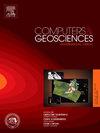Directional adaptive texture for edge detection in wide-azimuth seismic data
IF 4.2
2区 地球科学
Q1 COMPUTER SCIENCE, INTERDISCIPLINARY APPLICATIONS
引用次数: 0
Abstract
Seismic texture pattern analysis is one of the effective methods for edge detection, however existing methods fail to consider the differences in edge information inherent in pre-stack wide-azimuth seismic data from different offsets. This paper proposes an edge detection method based on directional adaptive texture pattern analysis (DATPA), fully using directional information for more accurate edge detection. Firstly, dip and azimuth data are obtained from 3D seismic data through structural gradient tensor decomposition, which are then considered as geological constraints to guide the calculation of high-precision dip and azimuth data. Using the corresponding relationship between high-precision dip and azimuth data and the direction and tendency of edge structures such as faults or channels, we adaptively determine the statistical directions sensitive to edge detection in multiple statistical directions constructed by interpolation methods. Pre-stack seismic texture analysis elements (STAE) are constructed in the determined direction, and the gray-level co-occurrence matrix algorithm is employed to obtain the pre-stack directional adaptive seismic texture attribute set. Next, the obtained seismic texture data set is subjected to dimensionality reduction and clustering using self-organizing maps (SOM), yielding the spatial distribution of different pre-stack directional adaptive seismic texture patterns. Finally, utilizing prior information from drilling and logging, we calibrate and analyze pre-stack seismic texture patterns related to edge structures like faults and channels, ultimately achieving edge detection based on DATPA. Field data demonstrate that compared with traditional seismic texture analysis methods, the texture patterns obtained by DATPA can effectively highlight edges in all directions while reflecting both local and overall discontinuity characteristics. The edge detection results align better with drilling data and display structural patterns more consistent with geologists' understanding, providing a reliable new approach for the precise detection of edges.
面向宽方位地震数据边缘检测的定向自适应纹理
地震纹理模式分析是一种有效的边缘检测方法,但现有方法未能考虑不同偏移量的叠前宽方位角地震数据所固有的边缘信息差异。本文提出了一种基于方向自适应纹理模式分析(DATPA)的边缘检测方法,充分利用方向信息进行更精确的边缘检测。首先,通过构造梯度张量分解从三维地震数据中获取倾角和方位角数据,并将其作为地质约束条件,指导高精度倾角和方位角数据的计算;利用高精度倾角和方位角数据与断层或通道等边缘结构的方向和倾向之间的对应关系,在插值方法构造的多个统计方向中自适应确定边缘检测敏感的统计方向。在确定的方向上构造叠前地震纹理分析元素(STAE),采用灰度共现矩阵算法获得叠前方向自适应地震纹理属性集。然后,利用自组织图(SOM)对得到的地震纹理数据集进行降维和聚类,得到不同叠前定向自适应地震纹理模式的空间分布。最后,利用钻井和测井的先验信息,对断层和通道等边缘结构相关的叠前地震纹理模式进行校正和分析,最终实现基于DATPA的边缘检测。实测数据表明,与传统的地震纹理分析方法相比,DATPA得到的纹理图可以在各个方向上有效地突出边缘,同时反映局部和整体的不连续特征。边缘检测结果与钻井数据更加吻合,显示的构造模式与地质学家的理解更加一致,为精确检测边缘提供了一种可靠的新方法。
本文章由计算机程序翻译,如有差异,请以英文原文为准。
求助全文
约1分钟内获得全文
求助全文
来源期刊

Computers & Geosciences
地学-地球科学综合
CiteScore
9.30
自引率
6.80%
发文量
164
审稿时长
3.4 months
期刊介绍:
Computers & Geosciences publishes high impact, original research at the interface between Computer Sciences and Geosciences. Publications should apply modern computer science paradigms, whether computational or informatics-based, to address problems in the geosciences.
 求助内容:
求助内容: 应助结果提醒方式:
应助结果提醒方式:


